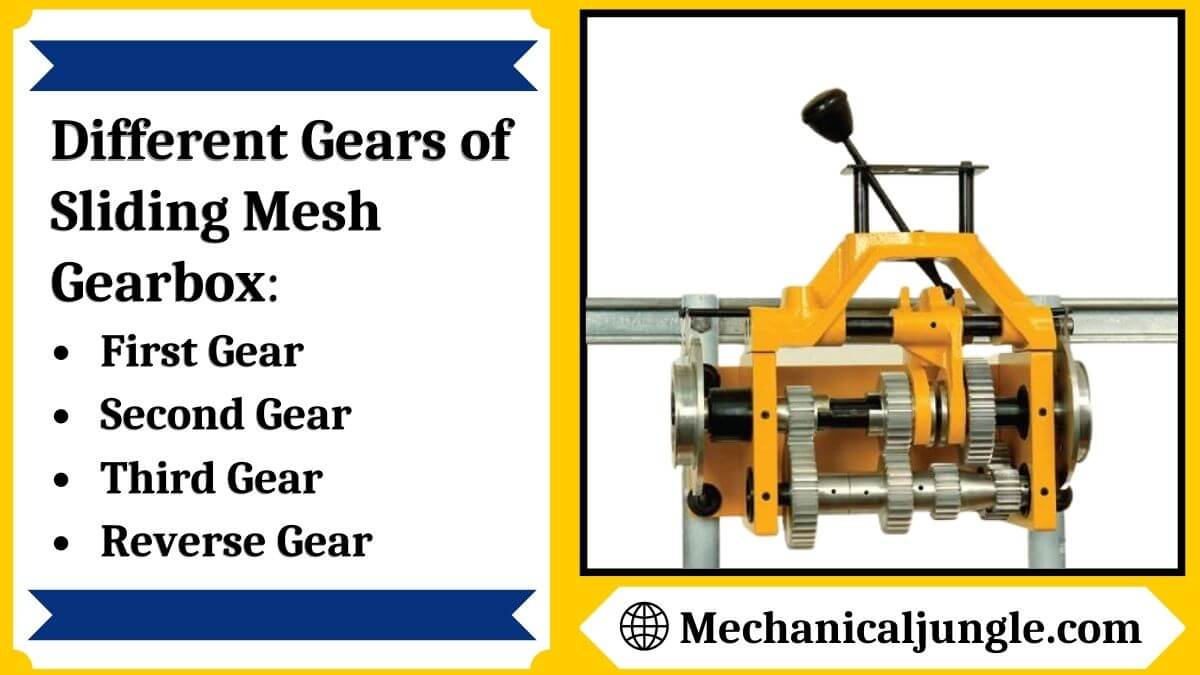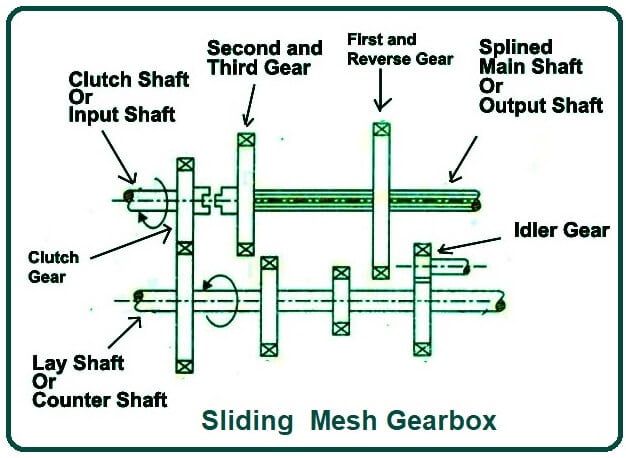Important Point
Sliding Mesh Gearbox:
The sliding mesh gearbox was the first gearbox or transmission system invented for automobiles. The first transmission system was delivered by French inventors Louis-René and Emile Levasore, who invented the world’s largest transmission system in 1894 with a 3-speed sliding mesh transmission.
The gear ratio is obtained by sliding the gear required to bring it with the proper mating gear. The sliding mesh gearbox is the gearbox that has the required gear ratio The necessary gear to get into the trap with the appropriate mating gear is obtained by slipping.
Since the gears have to slide axially and are exposed, the gears must essentially be gears. The development of the first moderns manual transmission was attributed to French inventors Louis-René Panhard and Emile Levasore.
This type of transmission offered several gear ratios. The gears were engaged by slipping on their shafts. Shifting gears was not an easy task; it could only be done by a skilled person.
When shifting gears, the gears that are required to rub together with each other must be at approximately the same speed as meshing.
The sliding mesh gearbox is now separated by a continuous-mesh gearbox in which all gears are forged with their pair at all times, and the Synchromesh gearbox is another refinement of the continuous mesh gearbox.
Also, Read: Velox Boiler | Construction of Velox Boiler | Principle of Volex Boiler | Working of Volex Boiler
Parts of Sliding Mesh Gearbox:
The main parts of the sliding mesh gearbox are:
- Shafts.
- Gears.
- Gear Lever.
Also, Read: Design of Knuckle Joint | What Is a Knuckle Joint? | Failure of Knuckle Joint
1. Shafts-
The sliding mesh gearbox has three shafts:
Clutch Shaft:- This sliding mesh gearbox has an input shaft. The clutch shaft carries the output of the engine to the gearbox with the help of an attractive and dismounted clutch that is mounted on the engine end. Above this shaft is mounted a gear, known as a clutch gear used to transmit rotational motion to the shaft.
Lay Shaft or Counter Shaft:- After input shaft left shaft, layshaft is an intermediate shaft between Clutch Shaft and Main Shaft. In the layshaft, the gears are fixed rigidly and rotate along the layshaft. One of the gears of this shaft is always in contact with the gear of the clutch shaft. So when the clutch shaft rotates, the shaft also rotates.
The layshaft rotates in a direction counter for engine rotation. So, it is also known as Counters Shaft. Other gears of layshaft mesh with different gears of main gears to obtain different gear ratios. In addition, the layshaft has a reverse gear with idler gear.
The Main Shaft:- This shaft is used as an outputs shaft in a sliding lattice gearbox. In this shaft, gears are not rigidly fixed. The gears of this shaft have grooves internally, and the outer surface of this shaft is made shiny so that the gears can slide easily on the shaft. The gears of the main shaft slide on the shaft to mesh with the appropriate gears to obtain the required gear ratios.
2. Gears-
Typically, two types of gears were used in sliding mesh gearboxes. They are: –
Spur Gear:- The spur gear has straight teeth that originate parallel to the axis of the gear. These gears are the most economical type of gears but have a tendency to vibrate and make noise at high speeds.
Helical Gear:- The helical gear teeth are not parallel to the gear axis. These gear-type teeth are at an angle to the gear axis. These gears are fewer noises and have a smoothers operation than spur gears. In addition, these gears have greater tooth strength and load-carrying capacity.
3. Gear Lever-
It is used to slide the gears to achieve proper gear ratios in the main shaft. It is operated by the driver.
Construction of Sliding Mesh Gearbox:
The clutch shaft attaches to the engine output and rotates as the engine rotates. A gear is attached to the clutch shaft, which is connected to the gear of the shaft.
The layshaft consists of several gears, one of which is attached to the gears of the clutch shaft, and the other gears connect to the different gears of the main shaft to achieve different gear ratios.
In addition, the shaft has a reverse gear and has an idler gear, which is placed between the shaft gear and the main shaft gear while operating. The main shaft has several gears, and these gears can slide to mesh the main shaft with different gears of the main shaft.
Working of Sliding Mesh Gearbox:
First, the clutch shaft is driven by the engine. It carries the output of the engine and rotates in the same direction as the engine. The gear attached to the clutch shaft also rotates. As the gear of the clutch shaft rotates, the shaft gear that is attached to the clutch shaft gear also rotates but in the opposite direction.
Hence the rotation of the layshaft gear causes the layshaft to rotate, which is determined by the stiffness in the layshaft. The rotation of the layshaft also causes other gears of the layshaft to rotate because all the gears of the layshaft are rigidly fixed, including the reverse gears.
The gears of the main shaft are internally split, and the main shaft is also split, so the gears of the main shaft can slide along it. The gears of the main shaft are shifted and meshed with different gears of different gears to achieve the different gear ratios required to withstand different road problems.
Different Gears of Sliding Mesh Gearbox:
The different gears of the sliding mesh gearbox are obtained in the following ways: –
- First Gear.
- Second Gear.
- Third Gear.
- Reverse Gear.
Also, Read: What Is the Quick Return Mechanism? | Types of Quick Return Mechanism
1. First Gear-
The first gear is used when the vehicle starts its movement in the forward direction. The first gear provides maximum torque and minimum speed, and this gear is achieved when the main shaft has the smallest gear on the shaft mesh with the largest gear.
2. Second Gear-
The second gear is achieved when the mid-size gear of the main shaft is accompanied by the second-largest gear of the second smallest gear in the shaft. The second gear provides lower torque and higher speed than the first gear.
3. Third Gear-
The third gear sliding mesh is the last gear or top gear of the gearbox. This gear is obtained when the shaft is the largest gear in the mesh with the smallest gear on the main shaft. This gear provides maximum speed and minimum power.
4. Reverse Gear-
Reverse gear is used when the vehicle needs to move in the opposite direction. In this gear, the rotation of the output shaft or main shaft is reversed by placing an idler gear between the recumbent shaft gear and the main shaft gear, which changes the direction of rotation of the output shaft.
Also, Read: Parts and Functions of Grinding Machine | Grinding Machine | Grinding Machine Types
Advantages of Sliding Mesh Gearbox:
Here, the different advantages of the sliding mesh gearbox are as follows.
- Since only one gear is in a mess in the sliding mesh gearbox, so fewer fluctuating loads on the shaft cause less vibration and noise, unlike the content mesh gearbox in which all gears are in constant mesh.
- Its efficiency is more than a constant gearbox as only one gear is in a mess, unlike the content mesh gearbox in which all gears are in constant mesh.
- Its manufacturing is easier as compared to a constant mesh gearbox.
- Its mechanism is simple.
Disadvantages of Sliding Mesh Gearbox:
Here, the different disadvantages of sliding mesh gearboxes are as follows.
- Only spur gears can be used because the gears are not in a continuous mesh-like stationary-mesh gearbox in which helical or herringbone gears may be used.
- Attaching the gears requires more effort because the gears have to slide into the sliding mesh gearbox, as opposed to a continuous mesh gearbox, where only one dog clutch has to slide for the engagement of different gears.
- Slipping traps occur in the gearbox due to greater wear and tear friction of the gear as the gear’s shorter life.
- It takes more time and money to change gears when the gearbox fails, but in a continuous mesh gearbox, only the dog clutches on failure fail, which takes less time and money.
Applications of Sliding Mesh Gearbox:
Here, the different applications of sliding mesh gearboxes are as follows.
- The sliding mesh gearbox is used in the Alfa 12HP with 4-speed manual transmissions.
- It is also used in Fiats 6HP with 3-speed manual transmissions.
- It is alsos used in Mercedes 35 HP & Renault Voiturettes.
Frequently Asked Questions (FAQ)
Sliding Mesh Gearbox
A sliding mesh gearbox is a transmission system that consists of various sets of gears and shafts that are arranged together in an organized fashion, and the shifting or meshing of different gear ratios is done by the sliding of gears towards the right and left over the splined shaft with the help of a gear lever operated by the driver.
Types of Gears Used in Sliding Mesh Gearbox
Sliding mesh gearboxes are made with spur gear. The gears in the layshaft are rigidly fixed shafts. The gears in the main shaft alone can move along the spline. The selector fork moves the gear and moves the perfect mesh with the required gear in the lay shaft when the gear lever is shifted.
Working of Sliding Mesh Gearbox
In a sliding mesh Gearbox, when the driver presses the gear pedal, the Gear slides (moves) on the output shaft and meshes with gears on the lay shaft. Therefore in such a way, when gear meshes, speed/torque obtains at the output shaft.
Advantages of Sliding Mesh Gearbox
The mechanism of this gearbox is simple compared to Constant Mesh Gearbox and Synchromesh Gearbox. There should be fewer fluctuating loads because only one gear is in mesh at a time.
Disadvantages of Sliding Mesh Gearbox
A sliding mesh gearbox has the following disadvantages: It has a high tear and wears since more friction occurs. It requires more effort for the engagement of gears. It is large in size as compared to a constant mesh gearbox.
Like this post? Share it with your friends!
Suggested Read –
- Difference Between Orthogonal and Oblique Cutting | Orthogonal Machining
- What Is Magneto Ignition System | How Does an Ignition System Work | How Does a Magneto Work | What Does a Magneto Do | Magneto Ignition System
- What Is a Synchromesh Gearbox? | Principle of Synchromesh Gearbox | Construction of Synchromesh Gearbox | Working of Synchromesh Gearbox
- Working of Constant Mesh Gearbox | What Is a Constant Mesh Gearbox? | Different Gear Ratios in Constant Mesh Gearbox | Construction of Constant Mesh Gearbox
- What Is Cupola Furnace? | Cupola Furnace Design । Cupola Construction | Purpose of Cupola | Working Principle of Cupola Furnace: | Advantages of Cupola Furnace | Disadvantages of Cupola Furnace | Applications of Cupola Furnace




Leave a Reply